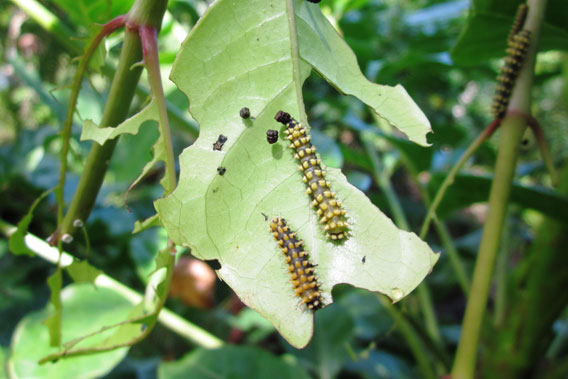
Moth larvae munching on a host plant. Photo by: Tom Corcoran.
For anyone who works in conservation in Madagascar, confronting the complex difficulties of widespread poverty is a part of the job. But with the wealth of Madagascar’s wildlife rapidly diminishing— such as lemurs, miniature chameleons, and hedgehog-looking tenrecs found no-where else in the world—the island-nation has become a testing ground for innovative conservation programs that focus on tackling entrenched poverty to save dwindling species and degraded places. The local NGO, the Madagascar Organization of Silk Workers or SEPALI, along with its U.S. partner Conservation through Poverty Alleviation (CPALI), is one such innovative program. In order to alleviate local pressure on the newly-established Makira Protected Area, SEPALI is aiding local farmers in artisanal silk production from endemic moths. The program uses Madagascar’s famed wildlife to help create more economically stable communities.
“We wanted to try a new approach to conservation that could replace the needs of local populations to harvest forest resources in areas of great biological importance,” Catherine Craig, founder of CPALI, told mongabay.com in a recent interview with herself and the SEPALI/CPALI team. The local NGO, SEPALI, was founded by M. Ratsimbazafy. “Madagascar has had a history of extreme poverty, forest loss and hence has a great need for effective conservation. In fact, Madagascar is the 13th most impoverished country in the world according to the Multidimensional Poverty Index and 80 percent of its population is engaged in subsistence agriculture. Despite millions of dollars in aid to protect Madagascar’s unique habitats, conservation efforts over the last 30 years have failed to stem species and habitat loss.”
 Designer Tara St. James’ CPALI silk skirt shown off at a fashion show in New York. Photo courtesy of Catherine Craig. |
Makira Protected Area, the largest on the island, was established in 2002 by then president, Marc Ravalomanana. The park is home to 22 species of lemur including several threatened species, such as the silky sifaka (Propithecus candidus), the black-and-white ruffed lemur (Varecia variegata), both listed as Critically Endangered by the IUCN Red List, and the indri (Indri indri), listed as Endangered. The park is also home to the Madagascar serpent eagle (Eutriorchis astur) and the island’s top predator, the fossa (Cryptoprocta ferox). Despite being seen initially as a conservation success, though now the park is imperiled by illegal logging, the protected area has impacted surrounding communities.
“Communities that once had access to the park’s resources now must abide by restrictions. Despite the fact they are not physically displaced, they are unable to gather the natural resources on which they previously depended and hence economically displaced,” explains Craig and her team, noting that a recent study found anemia rates among children have increased since the park’s demarcation, due to a decline in protein from bushmeat hunting.
Enter into the picture SEPALI and silk production.
“We sought to identify a sustainable, ecologically sound, income-generating program that allowed farmers to make between $60-$200 of added annual income to ensure the security of the Makira Protected Area. ”
Using three native moth species, each found in the region, SEPALI has begun to work with local farmers to raise wild silkworms on native trees and to sell unique silk products to an international market.
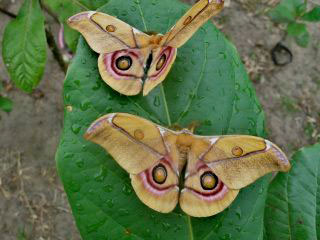 Silk producing moth Antherina surak. Photo by: Catherine Craig. |
“Silk cocoons provide a new, sustainable, source of income,” says Craig and her team, “chrysalides provide a new, alternative source of protein; silk moth host trees build up a protective green zone around the Makira Protected Area. Only 100 chrysalides to produce the eggs that yield 10,000 cocoons in the next season and 9,900 chrysalides, or approximately 10 kg of protein rich food, are available for human consumption, poultry feed or fertilizer.”
If successful, the program hopes to have an ecological impact (creating a buffer around the park with silkworm trees), an economic impact (additional source of income), a health impact (more protein), and a mitigating impact (less pressure on the park’s ecosystem and wildlife).
“By relying on a ‘proto-commodity’ (a good that is large enough to make a difference at the scale of a landscape but small enough to avoid industrial attention and competition) we hope to guard against the fluctuations in market prices that often affect the prices of commodities. We are proceeding by developing diverse markets for the silk that include architectural products, fashion accessories, home design products and lighting,” Craig and her team say, , adding that one of the best ways to help the program is to consider purchasing their products. The project’s non-spun textile can be viewed at any of the Material ConneXion’s product libraries around the world. Products can be seen online at wild silk markets and textiles can be ordered from source4style.
Currently, SEPALI is working in eleven communities with 126 farmers, over a third of which have planted at least 250 trees for silkworms.
If conservation is to succeed in a nation facing massive development problems, entrenched poverty, and a booming population, it is likely it will only be with the input of such multi-purposed programs like SEPALI’s.
In a February 2012 interview, Catherine Craig and SEPALI explained the purposes of their silkworm initiative, the challenges that have cropped up so far, and the importance of employing “social capital” to protect natural resources.
For additional information: Catherine Craig (ccraig@cpali.org) and Mamy Ratsimbazafy (mamycpali@gmail.com).
INTERVIEW WITH CATHERINE CRAIG AND THE CPALI/SEPALI TEAM
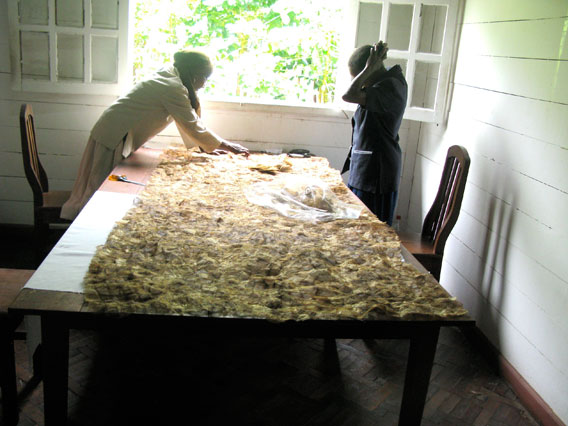
Making non-spun textile with Malagasy silk. Photo by: Catherine Craig.
Mongabay: What is your background?
Catherine Craig and the CPALI/SEPALI team: My background is in evolutionary biology and ecology. I taught and did research on the evolution of silk prior to starting my work on conservation through poverty alleviation.
Mongabay: Would you please summarize your work in Madagascar?
Catherine Craig and the CPALI/SEPALI team: In our program, farmers are taught how to raise wild (i.e., native) silk moths as a way to augment household income and improve land that borders a protected area. Husbandry of the silk moths encourages the planting of native vegetation on which the moths feed. We do not work in the protected area itself, only its periphery and only upon the invitation of the residents who manage the border lands. SEPALI Madagascar and its U.S.-based affiliate CPALI buy and market silk that has been produced sustainably according the protocols we have designed. We actively consult with the participants to adapt the project to their schedules and available resources. We have also refined the nature of the enterprise to respond to the requests of the participants.
Mongabay: How did you come to work in Madagascar?
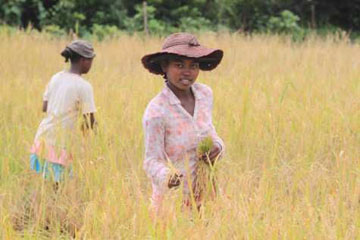 Malagasy woman working in the fields in the project area. Photo by: Tom Corcoran. |
Catherine Craig and the CPALI/SEPALI team: In 2000 we decided we wanted to try a new approach to conservation that could replace the needs of local populations to harvest forest resources in areas of great biological importance. Madagascar has had a history of extreme poverty, forest loss and hence has a great need for effective conservation. In fact, Madagascar is the 13th most impoverished country in the world according to the Multidimensional Poverty Index and 80% of its population is engaged in subsistence agriculture. Despite millions of dollars in aid to protect Madagascar’s unique habitats, conservation efforts over the last 30 years have failed to stem species and habitat loss. Nevertheless, Madagascar has remained one of the most important centers of world biodiversity and endemism and thus is a global conservation priority. Madagascar seemed like a good place to target a conservation enterprise approach that promised to also enhance environmental security.
MAKIRA PROTECTED AREA

Black-and-white ruffed lemur. Photo by: Rhett A. Butler.
Mongabay: Will you tell us about the history of the Makira Protected Area in Madagascar?
Catherine Craig and the CPALI/SEPALI team: The Makira Protected Area was established in 2002 and is a lowland and mid-altitudinal rainforest of about 371,000 hectares. More than 300,000 subsistence farmers are dependent on Makira Protected Area resources. Recent research shows that exclusion from the Makira Protected Area has resulted in increased anemia in children among households surrounding the Makira Protected Area (Golden 2011). Furthermore, despite good intentions, no agricultural improvements or crop diversifications have been broadly implemented since the Makira Protected Area was founded.
In addition to its ecological importance, we also had information from the Makira area about what the farmers needed to be able to afford to respect the protected area. In a 2003 survey, Minton found that 60 percent of the farmers economically displaced from the Makira Protected Area reported that they would forgo additional tavy [slash-and-burn agriculture] in the forest if they could earn $60/y of added income. Furthermore, farmers reported that they would forgo all use of forest resources if they could earn an additional $175 per year. Therefore, we sought to identify a sustainable, ecologically sound, income-generating program that allowed farmers to make between $60-$200 of added annual income to ensure the security of the Makira Protected Area. Our early techno-economic models suggested that our enterprise can meet that income requirement. What we did not count on was the political coup and subsequent logging concessions to international exploiters.
Mongabay: What are some of the notable features and species of this park?
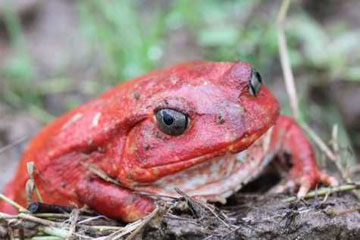 The aptly named tomato frog. Photo by: Tom Corcoran. |
Catherine Craig and the CPALI/SEPALI team: The Makira Protected Area together with the Masoala Penninsula is part of the largest remaining continuous forest left in the Eastern Forest Corridor. It contains 22 species of lemur including the silky sifaka, (Propithecus candidus), indri (Indri indri), black-and-white ruffed lemur (Varecia variegata), red-bellied lemur (Eulemur rubriventer), common brown lemur (Eulemur fulvus), white-headed lemur (Eulemur albifrons), and the eastern lesser bamboo lemur (Hapalemur griseus), hundreds of bird species and thousands of plant varieties found no where else on earth. It also contains a rich diversity of invertebrates not the least of which are 3 exceptionally beautiful silk-producing moths, Antherina suraka, Argema mittrei and Appolina ceranchia.
Mongabay: What are the current threats to this protected area?
Catherine Craig and the CPALI/SEPALI team: The greatest current threats to the protected area are increasing human populations, international logging of precious rosewood and ebony, mining for quartz and minerals and bushmeat hunting by loggers and for restaurants. Although some farmers have extended their crop area through tavy, at this point the greatest threat to Makira is timber exploitation made possible by international logging concessions.
Mongabay: You work with communities at the parks’ edges. Would you describe the people you work with as ‘conservation refugees’?
Catherine Craig and the CPALI/SEPALI team: Conservation refugees is a term generally used to describe populations that have been physically displaced or excluded from natural areas when land is set aside to be protected or incorporated into a national park. The Wildlife Conservation Society (WCS) designed the Makira Protected Area so that no existing populations were physically displaced. Nevertheless, as a protected area, by definition, communities that once had access to the park’s resources now must abide by restrictions. Hence, despite the fact they are not physically displaced, they are unable to gather the natural resources on which they previously depended. Being economically excluded from what was previously freely accessible makes local communities “conservation refugees.” While I appreciate and understand well the need to maintain exclusive sites for wildlife, protections, I have seen first hand that restricting access will not be effective unless economic alternatives are made available.
SILK AND LOCAL COMMUNITIES
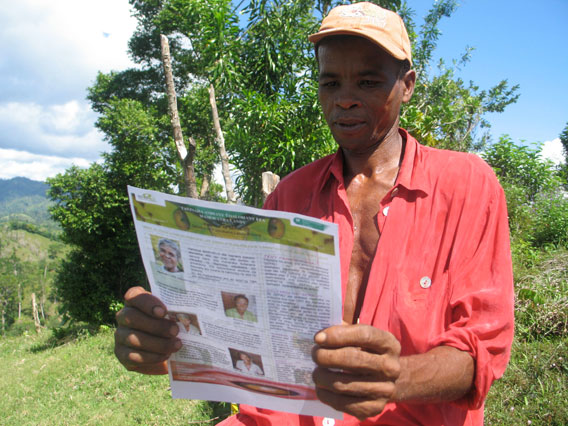
Local reading SEPALI newsletter. . Photo by Mamy Ratsimbazafy.
Mongabay: What is the difference between ‘social capital’ and ‘natural capital’?
Catherine Craig and the CPALI/SEPALI team: Natural capital represents the economic valuation of nature’s goods and services that ensure basic needs, for example, clean water, clean air, and insect pollination services. Natural capital valuations are critical to assessing the trade-offs between economic and environmental decisions that affect society; recognition of natural capital enables scientists to better understand and participate in the economics that underlie environmental policy.
Key to the success of natural capital approaches to environmental security is the assumption that law-abiding societies support stable government, that financial institutions exist to make the capital payments, and that legal institutions exist to secure restitution if they are not. Furthermore, population centers must be located “downstream” of the natural area that provides the goods and services. In developing countries where local populations are subsistence farmers, where governments are unstable and where financial institutions do not exist, natural capital approaches to environmental security do not thrive.
Social capital represents the money that can be saved by replacing physical constraints and remedies with cooperative ties among individuals and communities. A simple example is a community’s resolution to stop littering its public thoroughfares, which then permits saving the cost of periodic clean up.
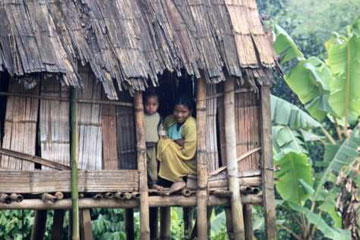 Children in the project area. Photo by: Tom Corcoran. |
Another easy to understand example of the economic value of social capital is the public’s obedience to traffic regulations even in the absence of police the resulting social good (safe driving) results from the relationships among individuals in the community. If the world were perfect, a great deal of money could be saved if taxes weren’t needed to support police departments. In the absence of enforced laws and/or in the presence of conflict, social capital is critical to achieving goals that promote a social good such as environmental protection. Social networks are the foundation on which economic networks are built; the capital is the trust that you will get paid for the goods that your neighbor has taken to market on your behalf.
SEPALI Madagascar and CPALI have worked to develop social capital networks that we are continually monitoring and improving to facilitate economic development, trade of goods and services and program implementation.
Mongabay: How are you using wild silk moth enterprises as a boon to local communities?
Catherine Craig and the CPALI/SEPALI team: The innovative CPALI/SEPALI Madagascar program is teaching farmers how to raise wild silkworms on native trees. Silk cocoons provide a new, sustainable, source of income; chrysalides provide an alternative protein source for food, poultry or crop fertilizer; silk moth host trees build up a protective green zone around the Makira Protected Area. Farmers are able to earn $30 (4000 cocoons) -$80 (8000 cocoons) of added income/year and artisans earn $8/m2 for sewing the textile. Furthermore, because farmers need only 100 chrysalides to produce the eggs that yield 10,000 cocoons in the next season, 3,900 chrysalides, or approximately 4 kilograms of protein rich food, can be used for consumption, poultry feed or fertilizer.
Mongabay: Why use endemic moths?
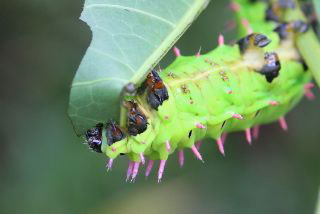 Antherina suraka eating hot plant, Talandoa. Photo by: Tom Corcoran. |
Catherine Craig and the CPALI/SEPALI team: We are using endemic moths for two reasons. First, Madagascar is rich in biodiversity and we hope to give rural people some insight into the value of the country’s riches and the importance in protecting them. Second, despite the diversity of silk moths, only silk moths in the genus, Borocera, found in the central plateau, have been used to produce textiles. We are introducing local farmers to endemic silk moths found throughout the Eastern Forest Corridor and teaching them how to raise silkworms on host trees inter-copped on family farms. Because the species are endemic, they are adapted to local environmental conditions. Because they are widespread, we are hoping they will be able to withstand the effects of climate change. By planting host trees and raising wild species we are adding value to existing farms and community managed forest that border the Makira Protected Area.
Second, we are trying to develop a market niche for silk spun by multiple wild species, such as Antherina suraka, Argema mittrei, Ceranchia appolina because of their unique physical properties and beauty. Other groups in Madagascar have introduced the domesticated silk moth and taught people how to rear it on the introduced, host tree, mulberry, as an income generating activity. However, the international market for domesticated silk is dominated by China. Madagascar because of its size and remoteness from markets will never be able to effectively compete in it. Wild silks are unique and characterized by exceptional beauty. Currently, India produces the greatest volume of wild silk but most of it is retained for in-country consumption. By relying on a “proto-commodity” (a good that is large enough to make a difference at the scale of a landscape but small enough to avoid industrial attention and competition) we hope to guard against the fluctuations in market prices that often affect the prices of commodities. We are proceeding by developing diverse markets for the silk that include architectural products, fashion accessories, home design products and lighting.
Mongabay: Why is silk farming both environmentally sustainable and economically beneficial?
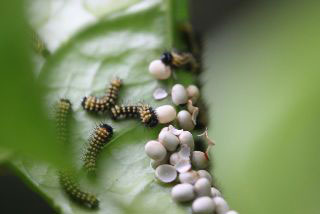 Hatching Antherina suraka eggs. Photo by: Tom Corcoran. |
Catherine Craig and the CPALI/SEPALI team: Wild silk farming is environmentally sound because of its focus on native host trees that can be used to recover degraded sites and build up border forests around protected areas and national parks. With the help of Cornell University’s Atkinson Center for Sustainability, we are initiating an environmental monitoring program to determine the effects of the host trees on soil nutrients and water retention. In 5 years time we will be able to determine if our initiative actually enhances soils.
The program is economically beneficial because subsistence farmers can effectively double their tradable income (median tradable income is $70/year; Golden 2011) if they produce two kilograms or 8000 cocoons. Silkworm chrysalides can be used for poultry feed, tree fertilizer or human consumption. It is much easier to raise silkworms than it is to clear forest for new crop sites. We designed the program, or I should say nature designed the program, so that silkworms are raised during year when farmers have free time. We predict that this is the same time of year when farmers would be most likely to cut new agricultural plots in the forest. We plan that participation in silk production will replace additional tavy.
CURRENT PROGRAM
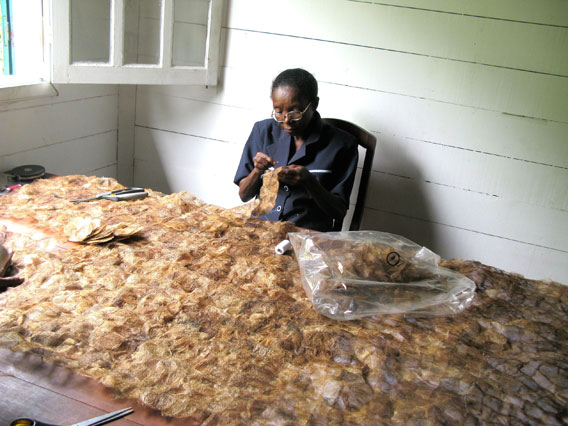
Working on a non-spun textile. Photo by: Catherine Craig.
Mongabay: You describe the program in Madagascar as a ‘test site’. How is the program progressing?
Catherine Craig and the CPALI/SEPALI team: The program is going well. While it took us about two years to identify the local host plant of Antherina suraka, thanks to our expanded team (and the generosity of our private and institutional donors) we are now working in 11 communities, with 6 farmer groups of 126 farmers; 45 farmers are members of SEPALI Madagascar (meaning they have planted a minimum of 250 host trees). SEPALI Madagascar has also organized 6 women’s groups who are making baskets and nets to support farmer activities. Thirteen of our farmers are learning how to breed the silk moths; our partners include 70 men and 58 women. We designed a unique, non-spun textile that we have sold in international markets.
Mongabay: Have you run into any particular challenges?
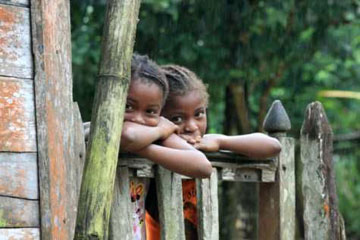 Children in the project area. Photo by: Tom Corcoran. |
Catherine Craig and the CPALI/SEPALI team: Initially, we had difficulty with program uptake. We have had to actively built up “social capital” to reassure farmers that we are not going to leave. Generally, we do not pay salaries but rather provide a market for cocoons and textiles (made to specification). By building groups of farmer leaders and artisan leaders we have been able to extend the program greatly. We started with 12 farmers in 2009 and grew to 83 in 2010 and 128 in 2011. I think we have met the first challenge of program participation. We now need to ensure that farmers build up production so we can develop a sustainable and expanding market.
Mongabay: How does this program mitigate impacts from local communities on the park?
Catherine Craig and the CPALI/SEPALI team: Our goal is to relieve community needs to use the park and give communities a new and sustainable means of generating income with the added benefit of protein/fertilizer supplements. However, to make the program sustainable, we project that we need to convince each of 200 farmers to produce 8000 cocoons per year. We will need to greatly expand the program to have an impact on Makira Protected Area security.
Mongabay: How is your program funded?
Catherine Craig and the CPALI/SEPALI team: The program has been funded by many, unusually generous, private donors—especially the Kenney family, the Norvig family and the Barclay family. In addition, we have received funding through Global Giving, Network for Good, the Rufford Small Grants for Conservation Foundation, the National Geographic Society, the Fulbright Foundation, Cornell University and in kind support from Harvard University.
Mongabay: Why has this been an advantage given the recent political upheavals in Madagascar?
Catherine Craig and the CPALI/SEPALI team: All major international aid agencies diminished or halted their activities in Madagascar after the 2009 coup. While some aid has returned, none of it is yet allotted to environmental programs. Since there has been no hope for any kind of governmental support, we have been completely dependent on foundation support and private donors. We have been very, very lucky. Our goal is make the program market-supported, economically sustainable and hence with no need of direct government, foundation or donor support in the future. That said, we recognize the remaining difficulties in building and maintaining markets and expect to have to rely on some sort of subsidies for a while.
Mongabay: Why is conservation in Madagascar dependent on poverty alleviation?
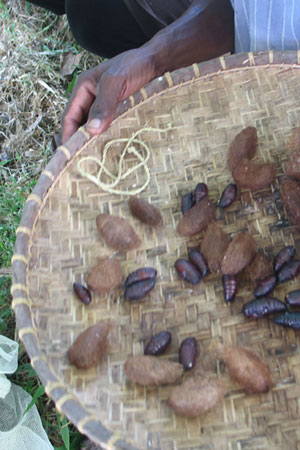 Chrysalides and cocoons. . Photo by Mamy Ratsimbazafy. |
Catherine Craig and the CPALI/SEPALI team: Madagascar’s highly dispersed rural population is dependent on harvesting natural resources for survival. For example, the people living around the edges of the Makira Protected Area are among the chronic poor meaning they have no opportunities to develop new products and new markets that can support their families. They, like Malagasy all over the country, are dependent on natural resources for survival. Without better education, communications and electricity they have no easy, rapid way of improving their lives. Without economic development, there are no financial institutions that the Malagasy can access for loans to build their business. Without infrastructure development there is no way to get products to market.
Mongabay: If successful could this model be used elsewhere in Madagascar?
Catherine Craig and the CPALI/SEPALI team: Our long-term goal is to make this model accessible to other parts of Madagascar as well as in other countries where natural capital approaches to conservation are not feasible. Wild silk moths are found all over Madagascar and in dry, wet, montane and lowland habitats. They are most diverse at the edges of protected areas and national parks. While the global production of domesticated silk represents a multi-billion dollar market, there is little competition for wild silk products because none are produced in commercial volumes. The silk model could be implemented elsewhere in Madagascar and will be most successful if production is aggregated to generate a commercial volume of wild silk. We decided early on to not rely on tourist trade since it is not predictable, sustainable or large enough to support the number of people in need to protect Madagascar’s rich biological resources.
Mongabay: How can people help?
Catherine Craig and the CPALI/SEPALI team: People can help by (patiently) purchasing our unique non-spun textile (wild silk markets; source4style; Habu Textile) for window shades, light shades, as well as for use in new products that they may be developing. Connecting the program to markets is critical. Replication of the CPALI/SEPALI program elsewhere in Madagascar, cooperation among implementers and sharing of ideas and approaches, and coordinated, cooperative marketing will extend the conservation impact that all of us are working to achieve.
Related articles
Photo: World’s smallest chameleon discovered in Madagascar
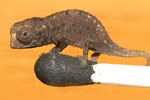
(02/15/2012) Scientists have discovered four new species of super-tiny chameleons in Madagascar, according to a new paper in PLoS ONE. The smallest of the new species, Brookesia micra, is found only on the small island of Nosy Hara and has been dubbed the smallest chameleon in the world, measuring from nose to tail 29 millimeters (1.14 inches) at its largest. Scientists believe it represents a notable example of island dwarfism.
Scientists create high resolution, 3D maps of forests in Madagascar
(02/15/2012) A team of scientists has created the first high resolution maps of remote forests in Madagascar. The effort, which is written up in the journal Carbon Balance and Management, will help more accurately register the amount of carbon stored in Madagascar’s forests, potentially giving the impoverished country access to carbon-based finance under the proposed REDD (Reducing Emissions from Deforestation and forest Degradation) program.
Caution urged in sale of Madagascar’s illegal timber stockpiles
(02/03/2012) Confiscated timber stocks in Madagascar must be managed in a “transparent manner” to deter future illegal logging and boosting demand for endangered rainforest timber, says a letter published by a coalition of NGOs.
How lemurs fight climate change
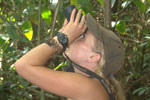
(01/09/2012) Kara Moses may have never become a biologist if not for a coin toss. The coin, which came up heads and decided Moses’ direction in college, has led her on a sinuous path from studying lemurs in captivity to environmental writing, and back to lemurs, only this time tracking them in their natural habitat. Her recent research on ruffed lemurs is attracting attention for documenting the seed dispersal capabilities of Critically Endangered ruffed lemurs as well as theorizing connections between Madagascar’s lemurs and the carbon storage capacity of its forests. Focusing on the black-and-white ruffed lemur’s (Varecia variegata) ecological role as a seed disperser—animals that play a major role in spreading a plant’s seeds far-and-wide—Moses suggests that not only do the lemurs disperse key tree species, but they could be instrumental in dispersing big species that store large amounts of carbon.
Photo: Tiny lemur discovered in Madagascar forest
(01/08/2012) A new species of mouse lemur has been discovered in eastern Madagascar, report researchers from Germany. The species is described in a recent issue of the journal Primates.
Cultural shifts in Madagascar drive lemur-killing
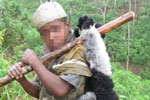
(12/15/2011) Conservationists have often found that some cultural norms, religious beliefs, and taboos play a role in holding back traditional peoples from overusing their environment. Examples of such beliefs include days wherein one cannot hunt or fish, or certain species or regions that are off limits to exploitation. But the influence of the modern world can rapidly extinguish such beliefs, sometimes for the better, in other cases not. In many parts of Madagascar, lemurs are off the menu. These primates, found only in Madagascar, play a big role in Malagasy ‘fady’ or taboo-related folk stories: lemurs are protectors and, in some cases, even relatives. However, according to a new paper in PLoS ONE an influx of migrants, widespread poverty, lack domestic meat, and poor law enforcement has caused a sudden rise in eating lemurs, many of which are already near-extinction due to habitat loss.
Madagascar tree diversity among the highest worldwide

(12/12/2011) In terms of biodiversity, the hugely imperiled forests of Madagascar may be among the world’s richest. Researchers estimate that the island off the coast of Africa is home to at least 10,000 tree and shrub species with over 90 percent of them found no-where else in the world. With little baseline data collected on Madagascar’s ecosystems, a new study, the first ever of tree diversity in Madagascar lowland rainforests, hopes to begin the process. Published in mongabay.com’s open access journal Tropical Conservation Science, the new study surveyed tree species in eastern Madagascar’s Betampona Special Reserve.
Forgoing bushmeat hunting has health toll in Madagascar, says study
(11/22/2011) Conservationists shouldn’t overlook the detrimental health impacts of shifting local populations away from subsistence bushmeat hunting, says a new study.
Critically Endangered lemurs disperse seeds, store carbon

(11/13/2011) Many tropical plants depend on other species to carry their progeny far-and-wide. Scientists are just beginning to unravel this phenomenon, known as seed dispersal, which is instrumental in supporting the diversity and richness of tropical forests. Researchers have identified a number of animal seed dispersers including birds, rodents, monkeys, elephants, and even fish. Now a new study in the Journal of Tropical Ecology adds another seed disperser to that list: the Critically Endangered black-and-white ruffed lemur (Varecia variegata). Capable of dispersing big tree species, the black-and-white ruffed lemur may even play a big role in carbon sequestration.
Photos: 40% of Madagascar’s reptiles at risk of extinction
(11/10/2011) 40 percent of Madagascar’s terrestrial reptiles are threatened with extinction due to habitat loss and over-collection for the pet trade, reports the International Union for Conservation of Nature (IUCN) in its latest update of the Red List of Threatened Species.
Madagascar interim president: sell rosewood stocks
(11/09/2011) Madagascar should sell its stocks of illegally logged rainforest timber, Madagascar’s interim leader Andry Rajoelina told the BBC in an interview.